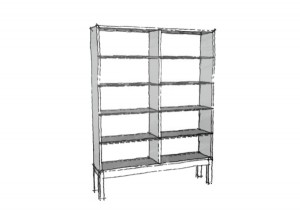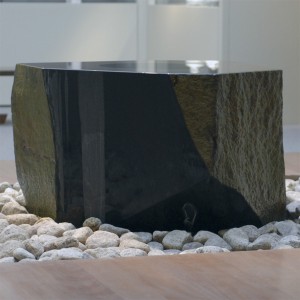My friends admired a bookcase by the Danish designer Børge Mogensen–and rightfully so: the stand-on-case design features a subtle interplay of details–between the case and top, between the varying thickness of stock, and between the shelf and case depth–that distinguish the piece. Unfortunately, the second floor of their one-and-a-half-story Craftsman bungalow couldn’t accommodate the case’s 63″ height. Clearly a shorter case was needed, but simply eliminating a couple of shelves while preserving the width of the original would create an ungainly design, an ill-proportioned stumpy case. Continue reading
Monthly Archives: June 2014
Finn Juhl-inspired Coffee Table–Construction
Construction began with the top. I cut a 3/4″ plywood panel 1/4″ undersized to account for the 1/8″ edge banding with my tracksaw set at angle to cut the bevel. After ripping stock into 1/8″ strips, I spread a bead of glue along the short plywood edges and gave it a minute to size the join, then applied another thin bead of glue and taped the banding in place with painter’s tape. When the glue dried, I trimmed the banding and then banded the long sides. While the glue dried, I cut the pattern for the legs and shaped it to final size, then roughed out leg blanks and routed them to final size. I’m glad I cut extra blanks since I destroyed several while trying to rout the curve of the stub out–the short grain is prone to blowout. Continue reading
Garden Fountain–Inspiration
Once of my favorite pieces at the Metropolitan Museum of Art is Isamu Noguchi’s “Water Stone.” It’s a study in contrasts, and not just the polished faces juxtaposed with rough edges of the basalt boulder. Set against a bed of pale stones, the dark rock exudes a delightful tranquility even as it disrupts the space of the gallery.
And it’s a bit of that tranquility we hope to replicate with our fountain in our own small way. Having acquired a small basalt boulder at Morrison Gravel, I’m going to see how effective an angle grinder at random orbital sander are at polishing stone . . .
Evolution of a TV Stand
My son has been enjoying The Police lately, so I’ve had ample time to contemplate the old TV stand I replaced last year, which now serves a stereo stand. I’m reminded of the difference time, taste, skill, and resources can make in a design. I’ve built three TV stands over the last fifteen years, and each one encapsulates the capabilities and materials available during construction.
The first was plywood, the shelves cut to size by the local lumberyard and housed in dadoes cut in the 2 x 4 legs with a circular saw. Screws secured the shelves to the dadoes. Then I finished it using paint leftover from an apartment remodel. The circular saw and cordless drill used to build the stand represented the bulk of tool collection at the time. The slanted front echoed the ladder bookshelves I’d built for the living room, and each shelf was designed for a specific component–receiver, VCR, and DVD player. Continue reading




